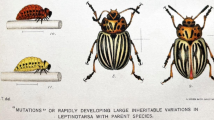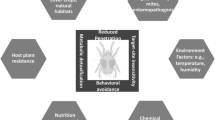Abstract
Populations of the whitefly, Bemisia tabaci collected from the Americas and the Caribbean Basin were examined for non-specific esterases and for the ability to induce characteristic phytotoxic disorders in key assay species as a means of investigating biogeographic diversity. Esterase markers were used to detect polymorphisms among regional B. tabaci populations and to establish the present distribution of B. tabaci biotypes in the region. The A biotype occurred only in contiguous locales in northern Mexico and the southwestern US, while the B biotype was present throughout much of the Caribbean Basin and the US, and in Brazil. Distinct C and D type esterase markers were observed for Costa Rican and Nicaraguan B. tabaci populations, respectively. The 0 or null type population was collected only from Jatropha gossypifolia (L.) in Puerto Rico. Laboratory colonies of the A and the B biotypes were almost equally sensitive to an organophosphate, profenofos. The B biotype was more resistant to a pyrethroid, permethrin, suggesting the existence of a biotype of B. tabaci, with a history of exposure to pesticides with a pyrethroid-based chemistry. In mating studies involving reciprocal crosses between the A and the B biotypes, very few F, female progeny were produced, indicating either minimal or non-existent reproductive compatibility between these haplo-diploid B. tabaci populations, presently considered to be the same species. Evidence is presented for the recent and widespread introduction, and subsequent spread of the B biotype throughout the US, the Caribbean Basin, and other proximal locations.
Résumé
Les populations de mouche blanche Bemisia tabaci collectionned à partir des ameriques, et le bassin des Antilles ont été examinees pur des esterases non specifiques et pour la capacité de provoquer des desordres phytoxiques caracteristiques des essaiés des especes comme un moyen d’etude de la diversité demographique. L’utilité de ces marqueurs pour detecter les differentes formes qui peut être servir de base pour etablir la distribution de B. tabaci biotypes dans la region etudieé. Le A biotype or biospecimen a été decouvert seulement dans les milieux contigus au nord du mexique et du sud-ouest de Etats-Unis, tandis que, le B biospecimen or biotype se trouve d’un bout à 1’ autre du bassin des Antilles et les Etats-Unis et au Bresil. Les marqueurs distincts de C et D esterases ont été observés respectivement pour les populations Costaricaines et Nicaraguaennes. Les colonies de laboratories du A et B biotypes exposes aux pestecides ont montré des pennlrlites permblables aux profenofos des organophosphates, tandis que C et D biotypes etaient soit suceptible ou extrement resistant respectivement au permethrin du pyrethroid suggerant l’evolution d’un biotype resistant au produit chimique due pyrethroid. Dans des etudes d’accouplement englobant des croisements reciproques entre les biotypes A et B la production des descendants feminins a été trés limitée indiquant un bas niveau de compatibilité entre les insects qui’sont haplo-diploides actuellement consideres comme etant’une seule espece. Des fails monveaux sont presentés pou la distribution recente du biotype B entirement dans les Etats-Unis et plusieurs milieux voisins.
Similar content being viewed by others
References
Alderman E. S. (1987) The sweet potato whitefly, a trade barrier that has growers talking. Florida Foliage. Sept. pp. 61–63.
Bedford I. D., Briddon R. W., Markham P. G., Brown J. K. and Rosell R. C. (1992) Bemisia tabaci — Biotype characterization and the threat of the whitefly species to agriculture. In Proc. 1992 British Crop Protection Conference. Pests and Diseases 3, 1235–1240.
Bethke J. A., Paine T. D. and Noressly G. S. (1991) Comparative biology, morphometrics, and development of two populations of Bemisia tabaci (Homoptera: Aleyrodidae) on cotton and poinsettia. Ann. Entomol. Soc. 84, 407–411.
Bharathan N., Narayanan K. R. and McMillan Jr., R. T. (1992) Characteristics of sweetpotato whitefly-mediated silverleaf syndrome and associated double-stranded RNA in squash. Phytopathology 82, 136–141.
Bird J. (1957) A whitefly-transmitted mosaic of Jatropha gossypifolia. Tech. Paper Agric. Exp. Station 22, 35.
Bird J. and Maramorosch K. (1978) Viruses and virus diseases associated with whiteflies. Adv. virus Res. 22, 55–110.
Brown J. K. (1990) An update on the whitefly-transmitted geminiviruses in the Americas and the Caribbean Basin. FAO Bull. 39, 5–23.
Brown J. K. (1992) Biotypes of the sweetpotato whitefly: a current perspective. In The Proc. 1992 Beltwide Cotton Conferences, Nashville, Tennessee, 6–10 January, 1992. pp. 665–670.
Brown J. K. and Bird J. (1992) Whitefly-transmitted geminiviruses and associated disorders in the Americas and the Caribbean Basin. Plant Dis. 75, 220–225.
Brown J.K., Costa H.S. and Bird J. (1991a) Variation in Bemisia tabaci populations based on geographic origin, silverleaf symptom induction, and esterase banding patterns. Phytopathology 81, 1157 (abstr.).
Brown J. K., Lastra R. and Bird J. (1991b) First documentation of whitefly-transmitted geminiviruses causing widespread disease in cotton, tobacco, and tomato in Dominican Republic, and in tomato in Puerto Rico. Fitopatologia 26, 47 (abstr.).
Brown J. K., Costa H. S. and Laemmlen F. (1992) First incidence of whitefly-associated squash silverleaf disorder of Cucurbita in Arizona, and of white streaking disorder of Brassica spp. in Arizona and California. Plant Dis. 76, 426.
Burban C., Fishpool L. D. C., Fauquet C., Fargette D. and Thouvenel J.-C. (1992) Host-associated biotypes within West African populations of the whitefly Bemisia tabaci (Genn.), (Horn: Aleyrodidae). J. Appl. Entomol. 113, 416–423.
Butler G. D. Jr. and Henneberry T. J. (1986) Bemisia tabaci (Genn.), a pest of cotton in the southwestern United States. US Department of Agriculture, Agric. Res. Serv. Techn. Bull. 1701, 119.
Byrne D. N. and Bellows T. S. Jr. (1991) Whitefly biology. Annu. Rev. Entomol. 36, 431–457.
Byrne D. N. and Miller W. B. (1990) Carbohydrate and amino acid composition of phloem sap and honeydew produced by Bemisia tabaci. J. Insect Physiol. 36, 433–439.
Byrne F. J. and Devonshire A. L. (1991) In vivo inhibition of esterase and acetylcholinesterase activities by profenofos treatments in the tobacco whitefly, Bemisia tabaci (Genn.): implications for routine biochemical monitoring of these enzymes. Pest. Biochem. Physiol. 40, 198–204.
Cock M. J. W. (ed.) (1986) Bemisia tabaci, A literature survey. FAO and CAB publication.
Cohen S., Duffus J.E., Liu H. Y. and Perry R. (1991) A new Bemisia tabaci (Genn.) biotype in the southwestern United States and its role in silverleaf of squash and transmission of lettuce infectious yellows virus. Phytopathology 82, 86–90.
Costa H. S. and Brown J. K. (1990) Variability in biological characteristics, isozyme patterns and virus transmission among populations of Bemisia tabaci Genn. in Arizona. Phytopathology 80, 888 (abstr.).
Costa H. S. and Brown J. K. (1991a) Biological characteristics and esterase patterns for Bemisia tabaci populations, and the association of silverleaf symptom development in squash with one population. In College of Agriculture Vegetable Report, Series. Coop. Ext. Serv., Agric. Exp. Stn., University of Arizona, Tucson, Arizona, pp. 79–83.
Costa H. S. and Brown J. K. (1991b) Variation in biological characteristics and in esterase patterns among populations of Bemisia tabaci Genn. and the association of one population with silverleaf symptom development. Entomol. exp. appl. 61, 211–219.
Costa H.S., Brown J.K. and Byrne D.N.(1991) Host plant selection by the whitefly, Bemisia tabaci Genn. (Homoptera:Aleyrodidae) under greenhouse conditions. J. Appl. Entomol. 112, 146–152.
Diehl S. R. and Bush G. L. (1984) An evolutionary and applied perspective of insect biotypes. Annu. Rev. Entomol. 29, 471–504.
Dittrich V. (1987) Resistance and hormoligosis as driving forces behind pest outbreaks. In Rational Pesticide Use (Edited by Brent K. Y. and Alein R. K.), pp. 169–181. Cambridge University Press.
Dittrich V., Ernst G. H., Ruesch O. and Solang U. K. (1990) Resistance mechanisms in sweetpotato whitefly (Homoptera: Aleyrodidae) populations from Sudan, Turkey, Guatemala, and Nicaragua. J. econ. Entomol. 83, 1665–1670.
Fransen J. J. (1990) Development of Bemisia tabaci Genn., (Homoptera: Aleyrodidae) on poinsettia and other pot plants grown under glass. SROP/WPRS Bull. XIII/5}, 61–63.
Hamon A. B. and Salguero V. (1987) Entomology Circular No. 292; February 1987. Florida Dept. Agric. and Consumer Services, Division of Plant Industry.
Haynes K. F., Miller T. A., Staten R. T., Li W.G. and Baker T. C. (1986) Monitoring insecticide resistance with insect phemmones. Experimentia 42, 1293–1295.
Lindquist R. K. and Tayama H. K. (1987) The sweet potato whitefly—another new pest for floriculture. Ohio State Flower Hotline 1, 1–2.
Maynard D. N. and Cantliffe D. J. (1989) Squash silverleaf and tomato irregular ripening: new vegetable disorders in Florida. Fla. Coop. Ext. Ser., IFAS VC-37, 4.
Mound L. A. and Halsey S. H. (1978) Whitefly of the World. Benham Press, Chichester, England.
Osman A. A., Watson T. F. and Sivasupramaniam S. (1991) Reversion of permethrin resistance in field strains and selection for azinphosmethyl and permethrin resistance in pink bollworm (Lepidoptera: Gelechiidae). J. econ. Entomol. 84, 353–357.
Plapp Jr. F. W., Jackman J. A., Campanlisla C., Frisbie R. E., Graves J. B., Luttrell R. G., Kitten W. F. and Wall M. (1990) Monitoring and management of pyrethroid resistance in the tobacco budworm (Lepidoptera: Noctuidae) in Texas, Mississippi, Louisiana, Arkansas, and Oklahoma. J. econ. Entomol. 83, 335–341.
Prabhaker N., Coudriet D. L. and Meyerdirk D. E. (1987) Discrimination of three whitefly species (Homoptera: Aleyrodidae) by electrophoresis of non-specific esterases. J. Appl. Entomol. 103, 447–451.
Russell L. M. (1957) Collection records of Bemisia tabaci (Gennadius) in the United States (Hemiptera: Homoptera: Aleyrodidae). USA Coop. Econ. Ins. Rep. 25, 229–230.
Sanderson J.P. (1987) Long Island Horticultural News, Nov. 1987.
Saxena R. C. and Barrion A. A. (1987) Biotypes of insect pests of agricultural crops. Insect Sci. Applic. 8, 453–458.
Schuster D. J., Kring J. B. and Price J. F. (1991) Association of the sweetpotato whitefly with a silverleaf disorder of squash. HortSci. 26, 155–156.
Schuster D. J., Mueller T. F., Kring J. B. and Price J. F. (1990) Relationship of the sweetpotato whitefly to a new tomato fruit disorder in Florida. HortSci. 25, 1618–1620.
Segarra Carmona A. E., Bird J. and Escudero J. (1990) Silvering of Cucurbita moschata (Duchesne) associated with Bemisia tabaci Germ. (Homoptera: Aleyrodidae) in Puerto Rico. J. Agric. Univ. Puerto Rico 74, 477–478.
Simone G. W., Brown J. K., Hiebert E. and Cullen R. C. (1990) Geminiviruses associated with epidemics in Florida tomatoes and pepper. Phytopathology 80, 1063.
Stenger D. C, Duffus J. E. and Villaion B. (1990) Biological and genomic properties of a geminivirus isolated from pepper. Phytopathology 80, 704–709.
Strandberg J. O., Hieben H., Leibee G. L. and Abouzid A. (1991) A new geminivirus with a broad host range in Brassicae. Phytopathology 81, 1244 (abstr.)
Wool D. and Greenberg S. (1990) Esterase activity in whiteflies (Bemisia tabaci) in Israel in relation to insecticide resistance. Entomol. Exp. Appl. 57, 251–258.
Wool D., Gerling D., Bellotti A. C, Morales F. J. and Nolt B. L. (1991) Spatial and temporal genetic variation in populations of the whitefly Bemisia tabaci (Genn.) in Israel and Colombia: an interim report. Insect Sci. Applic. 12, 225–230.
Wool D., Gerling D., Nolt B. L., Constantino L. M., Bellotti A. C. and Morales F. J. (1989) The use of electrophoresis for identification of adult whiteflies (Homoptera: Aleyrodidae) in Israel and Colombia. J. Appl. Entomol. 107, 344–350.
Yokomi R. K., Hoelmer K. A. and Osborne L. S. (1990) Relationship between the sweetpotato whitefly and the squash silverleaf disorder. Phytopathology 80, 895–900.
Author information
Authors and Affiliations
Rights and permissions
About this article
Cite this article
Costa, H.S., Brown, J.K., Sivasupramaniam, S. et al. Regional Distribution, Insecticide Resistance, and Reciprocal Crosses Between the A and B Biotypes of Bemisia Tabaci. Int J Trop Insect Sci 14, 255–266 (1993). https://doi.org/10.1017/S1742758400014703
Received:
Accepted:
Published:
Issue Date:
DOI: https://doi.org/10.1017/S1742758400014703




